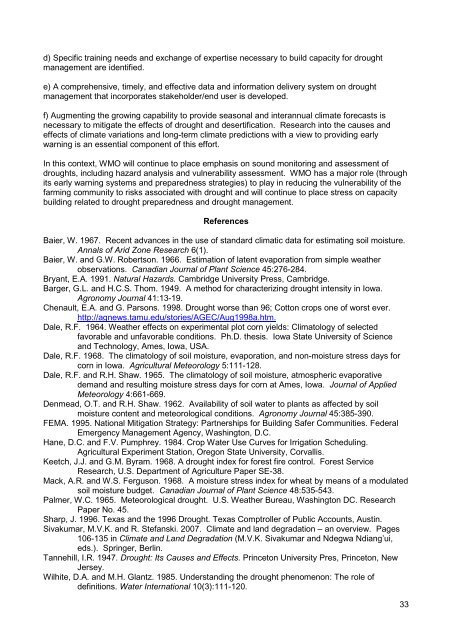Agricultural Drought Indices - US Department of Agriculture
Agricultural Drought Indices - US Department of Agriculture
Agricultural Drought Indices - US Department of Agriculture
Create successful ePaper yourself
Turn your PDF publications into a flip-book with our unique Google optimized e-Paper software.
d) Specific training needs and exchange <strong>of</strong> expertise necessary to build capacity for drought<br />
management are identified.<br />
e) A comprehensive, timely, and effective data and information delivery system on drought<br />
management that incorporates stakeholder/end user is developed.<br />
f) Augmenting the growing capability to provide seasonal and interannual climate forecasts is<br />
necessary to mitigate the effects <strong>of</strong> drought and desertification. Research into the causes and<br />
effects <strong>of</strong> climate variations and long-term climate predictions with a view to providing early<br />
warning is an essential component <strong>of</strong> this effort.<br />
In this context, WMO will continue to place emphasis on sound monitoring and assessment <strong>of</strong><br />
droughts, including hazard analysis and vulnerability assessment. WMO has a major role (through<br />
its early warning systems and preparedness strategies) to play in reducing the vulnerability <strong>of</strong> the<br />
farming community to risks associated with drought and will continue to place stress on capacity<br />
building related to drought preparedness and drought management.<br />
References<br />
Baier, W. 1967. Recent advances in the use <strong>of</strong> standard climatic data for estimating soil moisture.<br />
Annals <strong>of</strong> Arid Zone Research 6(1).<br />
Baier, W. and G.W. Robertson. 1966. Estimation <strong>of</strong> latent evaporation from simple weather<br />
observations. Canadian Journal <strong>of</strong> Plant Science 45:276-284.<br />
Bryant, E.A. 1991. Natural Hazards. Cambridge University Press, Cambridge.<br />
Barger, G.L. and H.C.S. Thom. 1949. A method for characterizing drought intensity in Iowa.<br />
Agronomy Journal 41:13-19.<br />
Chenault, E.A. and G. Parsons. 1998. <strong>Drought</strong> worse than 96; Cotton crops one <strong>of</strong> worst ever.<br />
http://agnews.tamu.edu/stories/AGEC/Aug1998a.htm.<br />
Dale, R.F. 1964. Weather effects on experimental plot corn yields: Climatology <strong>of</strong> selected<br />
favorable and unfavorable conditions. Ph.D. thesis. Iowa State University <strong>of</strong> Science<br />
and Technology, Ames, Iowa, <strong>US</strong>A.<br />
Dale, R.F. 1968. The climatology <strong>of</strong> soil moisture, evaporation, and non-moisture stress days for<br />
corn in Iowa. <strong>Agricultural</strong> Meteorology 5:111-128.<br />
Dale, R.F. and R.H. Shaw. 1965. The climatology <strong>of</strong> soil moisture, atmospheric evaporative<br />
demand and resulting moisture stress days for corn at Ames, Iowa. Journal <strong>of</strong> Applied<br />
Meteorology 4:661-669.<br />
Denmead, O.T. and R.H. Shaw. 1962. Availability <strong>of</strong> soil water to plants as affected by soil<br />
moisture content and meteorological conditions. Agronomy Journal 45:385-390.<br />
FEMA. 1995. National Mitigation Strategy: Partnerships for Building Safer Communities. Federal<br />
Emergency Management Agency, Washington, D.C.<br />
Hane, D.C. and F.V. Pumphrey. 1984. Crop Water Use Curves for Irrigation Scheduling.<br />
<strong>Agricultural</strong> Experiment Station, Oregon State University, Corvallis.<br />
Keetch, J.J. and G.M. Byram. 1968. A drought index for forest fire control. Forest Service<br />
Research, U.S. <strong>Department</strong> <strong>of</strong> <strong>Agriculture</strong> Paper SE-38.<br />
Mack, A.R. and W.S. Ferguson. 1968. A moisture stress index for wheat by means <strong>of</strong> a modulated<br />
soil moisture budget. Canadian Journal <strong>of</strong> Plant Science 48:535-543.<br />
Palmer, W.C. 1965. Meteorological drought. U.S. Weather Bureau, Washington DC. Research<br />
Paper No. 45.<br />
Sharp, J. 1996. Texas and the 1996 <strong>Drought</strong>. Texas Comptroller <strong>of</strong> Public Accounts, Austin.<br />
Sivakumar, M.V.K. and R. Stefanski. 2007. Climate and land degradation – an overview. Pages<br />
106-135 in Climate and Land Degradation (M.V.K. Sivakumar and Ndegwa Ndiang’ui,<br />
eds.). Springer, Berlin.<br />
Tannehill, I.R. 1947. <strong>Drought</strong>: Its Causes and Effects. Princeton University Pres, Princeton, New<br />
Jersey.<br />
Wilhite, D.A. and M.H. Glantz. 1985. Understanding the drought phenomenon: The role <strong>of</strong><br />
definitions. Water International 10(3):111-120.<br />
33

















